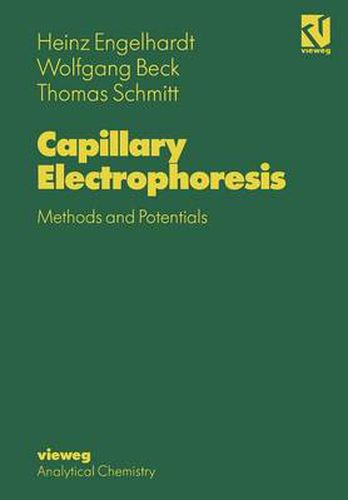Readings Newsletter
Become a Readings Member to make your shopping experience even easier.
Sign in or sign up for free!
You’re not far away from qualifying for FREE standard shipping within Australia
You’ve qualified for FREE standard shipping within Australia
The cart is loading…






This title is printed to order. This book may have been self-published. If so, we cannot guarantee the quality of the content. In the main most books will have gone through the editing process however some may not. We therefore suggest that you be aware of this before ordering this book. If in doubt check either the author or publisher’s details as we are unable to accept any returns unless they are faulty. Please contact us if you have any questions.
Capillary electrophoresis (CE), also designated by the acronym HPCE for High Per- formance Capillary Electrophoresis is a rapidly growing analytical separation method. It unites the separation technique of classical electrophoresis on plates with the instrumental methods of chromatography with respect to direct detection of the solutes separated in the capillary and their ready identification and quantification. The initial problems of inadequate reproducibility in quantitative analysis, due to the necessity of handling extremely small volumes, have largely been solved in the sec- ond generation commercial instruments. Hence, a rapid and reliable separation sys- tem is available for ionic compounds from the smallest cation (the lithium ion) up to poly anions with molecular weights ranging in the millions (such as DNA molecules). The methods of gel electrophoresis and isoelectric focusing can be readily extended to separation techniques carried out in a capillary. For nonionic compounds an addi- tional separation method is available in the form of micellar electrokinetic chroma- tography (MEKC). This involves a true chromatographic separation process because the distribution of the analytes between the buffer and the micelles is superimposed on the electrophoretic migration, which contributes substantially to the selectivity.
$9.00 standard shipping within Australia
FREE standard shipping within Australia for orders over $100.00
Express & International shipping calculated at checkout
This title is printed to order. This book may have been self-published. If so, we cannot guarantee the quality of the content. In the main most books will have gone through the editing process however some may not. We therefore suggest that you be aware of this before ordering this book. If in doubt check either the author or publisher’s details as we are unable to accept any returns unless they are faulty. Please contact us if you have any questions.
Capillary electrophoresis (CE), also designated by the acronym HPCE for High Per- formance Capillary Electrophoresis is a rapidly growing analytical separation method. It unites the separation technique of classical electrophoresis on plates with the instrumental methods of chromatography with respect to direct detection of the solutes separated in the capillary and their ready identification and quantification. The initial problems of inadequate reproducibility in quantitative analysis, due to the necessity of handling extremely small volumes, have largely been solved in the sec- ond generation commercial instruments. Hence, a rapid and reliable separation sys- tem is available for ionic compounds from the smallest cation (the lithium ion) up to poly anions with molecular weights ranging in the millions (such as DNA molecules). The methods of gel electrophoresis and isoelectric focusing can be readily extended to separation techniques carried out in a capillary. For nonionic compounds an addi- tional separation method is available in the form of micellar electrokinetic chroma- tography (MEKC). This involves a true chromatographic separation process because the distribution of the analytes between the buffer and the micelles is superimposed on the electrophoretic migration, which contributes substantially to the selectivity.